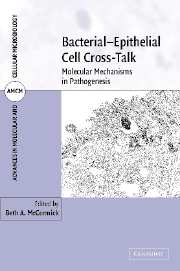Book contents
- Frontmatter
- Contents
- List of contributors
- Part I Introduction to the host and bacterial pathogens
- 1 Overview of the epithelial cell
- 2 Evolution of bacterial pathogens
- Part II Bacterial cell biology and pathogenesis
- Part III Host cell signaling by bacteria
- Part IV Exploitation of host niches by pathogenic bacteria: mechanisms and consequences
- Index
- Plate section
- References
2 - Evolution of bacterial pathogens
from Part I - Introduction to the host and bacterial pathogens
Published online by Cambridge University Press: 12 August 2009
- Frontmatter
- Contents
- List of contributors
- Part I Introduction to the host and bacterial pathogens
- 1 Overview of the epithelial cell
- 2 Evolution of bacterial pathogens
- Part II Bacterial cell biology and pathogenesis
- Part III Host cell signaling by bacteria
- Part IV Exploitation of host niches by pathogenic bacteria: mechanisms and consequences
- Index
- Plate section
- References
Summary
INTRODUCTION
The evolution of bacterial pathogens is essentially the story of how all life evolves. It is a story of mutation and selection, of adaptation and survival, of incremental genetic changes and quantum leaps in genome content. All organisms evolve, but the evolution of microbes is the best studied. The short generation times of microbes and the ability to grow individual populations to large numbers allow researchers to study rare events over many generations – something that is next to impossible with larger, more complex organisms such as fruit flies, mice, and humans.
This chapter begins with a brief overview of the principles of mutation and selection in bacteria. This background will prepare the reader for the subsequent sections that will discuss the various forms of horizontal gene transfer (HGT) and how they each contribute to bacterial evolution. Specific examples are presented to give the reader insight into the enormous power of genetic selection as well as the great diversity of pathways that bacteria take in adapting to their environment. We also highlight some recurrent themes in bacterial pathogenesis. The chapter concludes with a discussion of a new paradigm of bacterial pathogen evolution that involves the loss of gene function as an adaptation to colonization of the host. The concept of pathoadaptation is introduced and expanded to include selection for gene loss as the pathogen improves its fitness within the host niche.
- Type
- Chapter
- Information
- Bacterial-Epithelial Cell Cross-TalkMolecular Mechanisms in Pathogenesis, pp. 30 - 56Publisher: Cambridge University PressPrint publication year: 2006

